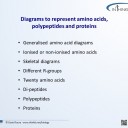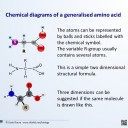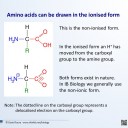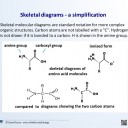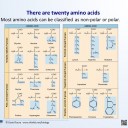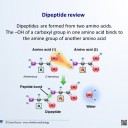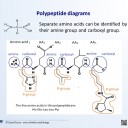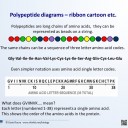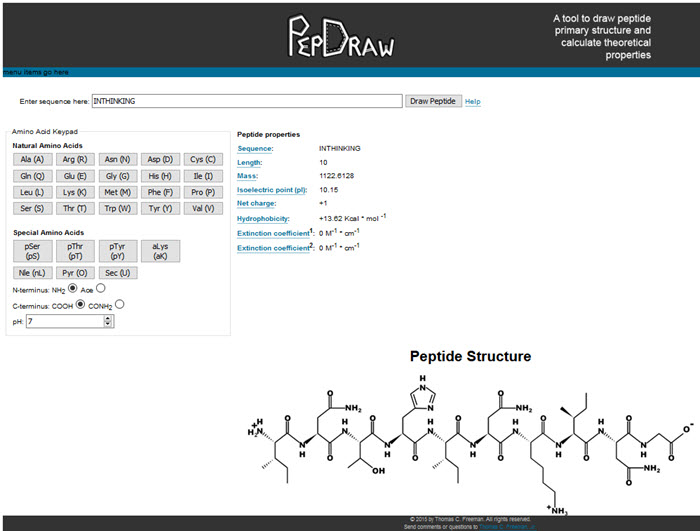Polypeptide structure
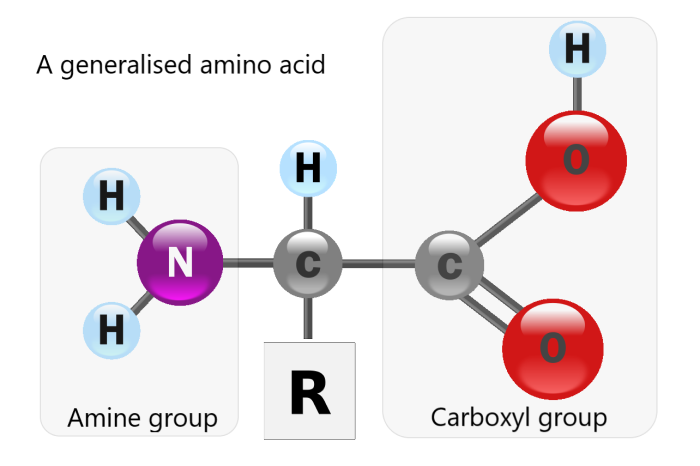 Proteins are the second most common molecule after water. In this activity students learn how proteins are formed from amino acids. To explain the formation of a peptide bond it is important to understand chemical molecule diagrams and how they are often simplified. The twenty standard amino acids are introduced as well as the use of three letter and single letter abbreviations. The activity includes a fun polypeptide message and the use of online molecule imaging tools. Details of selenocystine, an interesting non-standard amino acid found in broccoli and humans is introduced within an IB style question.
Proteins are the second most common molecule after water. In this activity students learn how proteins are formed from amino acids. To explain the formation of a peptide bond it is important to understand chemical molecule diagrams and how they are often simplified. The twenty standard amino acids are introduced as well as the use of three letter and single letter abbreviations. The activity includes a fun polypeptide message and the use of online molecule imaging tools. Details of selenocystine, an interesting non-standard amino acid found in broccoli and humans is introduced within an IB style question.
Lesson Description
Guiding Question
What is the relationship between a chain of amino acids and a fully functioning protein, like an enzyme?

Activity 1 - Understanding chemical diagrams of polypeptides
Look through these slides which explain the different representations of amino acids and polypeptides in biochemical diagrams.
They also introduce how proteins can be formed from chains of amino acids each joined by a peptide bond.
https://askabiologist.asu.edu/venom/protein-art to find out more about different representations of protein molecules.
Activity 2: Build a designer polypeptide peptide.
Use the simple online tool Pepdraw to build a personalised polypeptide. Try writing your name using single letter codes,
Copy the peptide structure produced by Pepdraw and annotate the parts of each individual amino acid in the polypeptide.
Use this worksheet ![]() Polypeptide structure worksheet to complete your notes.
Polypeptide structure worksheet to complete your notes.
Activity 3 - IB style question based on biological data about an unusual amino acid
Read this short extract, adapted from a research paper from the Indian Academy of Sciences
J. Chem. Sci., Vol. 117, No. 4, July 2005, pp. 287–303.© Indian Academy of Sciences.
Selenium-containing enzymes in mammals: Chemical perspectives
Selenium was discovered in 1818 by the Swedish chemist Berzelius and was named after the Greek moon goddess, Selene.
In Biology, selenium was long considered to be a poison until Schwarz and Foltz identified it as a micro-nutrient for bacteria, mammals, and birds. In 1973, after 15 years of studies on selenium-deficiency syndrome in experimental animals, biochemists discovered two bacterial enzymes, formate dehydrogenase3 and glycine reductase, which contain selenium. At the same time, it was found that selenium is part of the active site of the antioxidant enzyme glutathione peroxidase (GPx)
The most common biological form of selenium is represented by the amino acid selenocysteine (Sec). Selenocysteine is now considered to be the 21st amino acid. The presence of a Sec amino acid in the active site of an enzyme instead of a non-selenium containing amino acid (Cys) gives a dramatic catalytic advantage.
This is the structure of the selenium containing amino acid, selenocysteine.
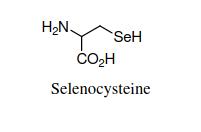
Questions
1) Draw a simple 2D molecule diagram to represent the R-group of the amino acid selenocysteine. Represent carbon atoms with the letter 'C' rather than giving a skeletal diagram. (2 marks)
.
.
.
2) Outline why it is surprising to find a 21st amino acid containing the element selenium in 1973. What did biologists think about amino acids and selenium before this time? (2 marks)
..............................................................................................................
..............................................................................................................
..............................................................................................................
Teachers notes
This lesson could be a homework activity or an extension lesson for a bright class. The activities build on the essentials and helps students to make connections between different visualisations of polypeptides and proteins. Sometimes students learn about the formation of di-peptides, but don't make the link between this simple reaction and the giant protein molecules which form the bodies of living organisms.
Activity 1: There are several different types of notation which can be found for amino acids and proteins and the first activity explains the rational behind some types of structure diagrams.
Students who are already confident about the structure of amino acids and condensation reactions from earlier classes will complete the work quickly.
Activity 2: is a light hearted approach to explaining the structure of a polypeptide. It uses an online tool to quickly produce a structural diagram of a polypeptide. Students will show their understanding of activity 1 by completing the diagram activity in this part.
A third activity is in the planning stages, but will appear soon.
Alternative visualisation project for activity 3
Research for specific di-peptide molecules and draw diagrams of their structure.
Here is one example, a di-peptide made from the amino acids glycine and alanine.
https://molview.org/?cid=25264215
To draw more di-peptides use these JSmol 3D visualisations of all the amino acids at Biotopics (no plugin required)
Make a 'pretty' version of your polypeptide using another online molecule visualisation tool.Molview is one good example.
This link will take you to a di-peptide made from three amino acids, His-Pro-Gly https://molview.org/?cid=25264215
Explore the 3D structure of this tri-peptide, or search for other di-peptide visualisations.
Take screenshots and label the component parts as done using Molview.
Activity 3: IB Style Question covers the guidance from IB Guide, 2.4 Proteins
Students should know that most organisms use the same 20 amino acids in the same genetic code although there are some exceptions. Specific examples could be used for illustration.
The details of the question is based on information from the paper e.g. http://repository.ias.ac.in/79332/1/53-PUB.pdf
 IB Docs (2) Team
IB Docs (2) Team











